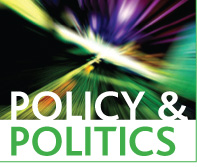Christopher Ansell, Eva Sørensen and Jacob Torfing
The Policy and Politics section of Discover Society is provided in collaboration with the journal Policy & Politics. The section is curated by Sarah Brown.
Implementation problems defined by the failure to turn public policies into practice and deliver the intended results and effects are pervasive at all levels of government and highlighted by the new focus on performance measurement that triggers mediatized blame-games. Public decision-makers spend a lot of time and effort creating public policy solutions that can muster political support in parliamentary assemblies and then leave policy implementation to public administrators in the expectation that the desired results will be achieved. However, numerous studies have shown that there is often a considerable gap between the planned outputs and outcomes of public policy and what actually happens. The failure to deliver public policies is highly problematic as it undermines the governing capacity of democratically elected politicians and tends to leave pressing societal problems unsolved.
While the traditional implementation theories primarily have located the obstacles to policy implementation within public bureaucracy, we propose that implementation problems are often rooted in bad policy designs and the failure to adjust policies to local conditions and emerging problems.
Taking a collaborative approach to public policymaking may solve both of these problems. Collaboration between upstream and downstream policy actors will not only tend to spur processes of mutual learning and policy innovation, but also help to ensure a flexible adaptation of the content of public policies and the plans for their implementation in order to match the conditions on the ground.
The implementation of public policies often leads to a far less than expected take-up, poor service quality, budget transgressions, failure to reach stated objectives, unforeseen externalities, and a limited impact on the problems that the new policies were supposed to solve. Classical implementation theories explain such implementation problems as a result of the presence of: 1) long-stretched implementation chains that accumulate deviations from the original policy strategy; 2) coping-strategies advanced by street-level bureaucrats capable of exercising a high degree of discretion when implementing new policies; and 3) ignorance, opposition and non-compliance of recalcitrant target groups operating within socioeconomic subsystems that are foreign to the logic imposed by the new policy. As such, it is the structure and operation of public bureaucracy and its lack of responsiveness that are blamed for the numerous failures to implement public policies.
New Public Management suggests that the introduction of performance management, the skillful use of a mixture of transactional and transformative leadership and the creation of exit and voice options for the service users will cure the apparent illness of public bureaucracy. However, this solution tends to reinforce the separation between policy design and policy execution and thus prevents us from addressing the implementation problems pertaining to the design of public policies.
Public policies are often flawed and ill conceived, making them almost impossible to implement for even the most competent and motivated public administrators. The problem is not merely that the policymakers suffer from cognitive limitations in the sense that they lack evidence that the new program theory will work or that they fail to anticipate obvious implementation problems such as lack of skills and insufficient budget allocations. In most cases, the policy-design problem goes much deeper as it is rooted in the failure to identify and align problems, solutions, interests and organizational routines and resources in a comprehensive manner that takes into account the local knowledge about the conditions on the ground.
In our recent Policy & Politics article, we argue that policy designs can be improved through collaboration between relevant and affected policy actors, including elected politicians, public managers, service providers, user groups and interest organizations. Multi-actor collaboration based on deliberation tends to bring forth relevant knowledge, stimulate processes of mutual learning and build joint ownership over the new solutions. Since the implementation of well-crafted policy designs cannot be ensured through traditional top-down implementation based on command and control, the collaboration design process should be extended in order to enable the adaptation of the initial policy design to better reflect local conditions and emerging problems and challenges. As such, policy design should be seen as an ongoing process that flexibly adapts as implementation challenges unfold.
Taking a more collaborative approach to designing and flexibly adapting public policies tends to blur the sharp lines of demarcation between design and execution, top and bottom, and public and private. Moreover, it helps us realize that implementation problems are not solved by managerial ploys aiming to clarify and communicate the policy objectives, plan the implementation process, evaluate performance and reward high performers/punish low performers. As such, the core of our argument is that the New Public Management agenda fails to address the heart of the so- called ‘policy execution problems’. More relevant solutions to perennial implementation problems are predicated on the new ideas of innovation, collaboration and resource mobilization set out by the New Public Governance perspective.
Our recommendation of a collaborative approach to the formulation and implementation of public policy begs the question of whether it is possible to motivate the various public and private actors to participate in collaborative processes of policy design and flexible adaptation. Public administrators, interest organizations and target users stand to gain considerable influence from active participation and this might be a strong motivating factor. By contrast, elected politicians might, for a number of reasons, be reluctant to embrace the idea of collaborative policy implementation. Many politicians see themselves as sovereign decision-makers who have all the power and responsibility, so they might not be prepared to share their power with non-political actors. Some politicians are driven by strong ideological convictions and are so uncompromising that they are unsuitable for participation in collaborative governance. Other politicians are closely tied to particular interest groups and thus may fear that political compromises obtained in and through collaborative policy-processes will harm the interests that they aim to protect. Last but not least, our mediatized drama-democracies place enormous pressures on politicians to act swiftly by promising a quick fix and make politics personal and confrontational. While such actions seem to offer a recipe for politicians to get good media coverage, they are antithetical to collaborative governance that tends to favor long-term processes which aim to find collective solutions based on compromise formation.
The obstacles to politicians’ participation in collaborative policymaking are real, but they are not impossible to overcome. Indeed, many politicians are eager to strengthen their political leadership during hard times that call for innovative and effective solutions to wicked and unruly problems. Collaborative policymaking provides a potent tool for soliciting the inputs, ideas and resources that politicians need to create the kind of solutions that will take their political community forward. As such, there are many examples of politicians seeking inputs from relevant and affected actors that enhance their understanding of the problems at hand and inspire them to formulate new and better solutions. New forms of interactive political leadership are emerging, frequently supported by new institutional designs. In Gentofte Municipality in Denmark, the local councilors have drastically reduced the time spent on case processing in Standing Committees. Instead they have created a new kind of thematic ad hoc committee called ‘Task Committees’, where they aim to tackle the most pressing problems confronting the local community by developing policy solutions through a sustained interaction with local citizens and stakeholders. The result is not only that policy designs are more well informed and better suited to solve the problems than before. In addition, the implementation of the new designs is also faster and more flexible.
To summarize, our article offers a new solution on a classical problem: the failure to implement public policy. Instead of further pursuing the idea that the new managerialism will close the gap between planned and actual policy outputs and outcomes, we advocate the idea of collaborative policy design and flexible adaptation to emerging problems and challenges. Our argument is based on a critical evaluation and constructive extension of implementation theory and aims to foster a rapprochement between the classical implementation theories and the new theories of collaborative governance. Our hope is that this will open a new line of research that analyses the process and impact of collaborative policy design and adaptive implementation, and explores the prospects for the development of an interactive political leadership that allows elected politicians to reap the fruits of collaborative governance.
Hitherto, students of public administration and public policy have seen collaborative governance as a tool for policymaking in a world of shared power. Now, it is time to consider how multi-actor collaboration can improve policy execution and prevent or mitigate implementation problems. A combination of systematic design experiments and comparative case studies will enable us to pinpoint the conditions for engaging upstream and downstream policy actors in collaborative design and flexible adaptation of effective public policies. Hence, the sooner researchers and practitioners join forces and set up a joint investigation of the intrinsic link between institutional conditions, collaborative policymaking and the capacity to ensure the implementation of new policies, the sooner we can begin to restore trust in our elected political leaders and to help those segments of the population that suffer as a result of policy failures.
Christopher Ansell is Professor of Political Science at University of California Berkeley. Eva Sørensen is Professor in the Department of Social Sciences and Business at Roskilde University. Jacob Torfing is Professor in the Department of Social Sciences and Business at Roskilde University and Director of the School of Governance.

